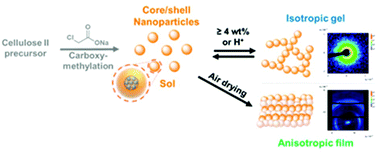Soft cellulose II nanospheres: sol–gel behaviour, swelling and material synthesis†
Abstract
High axial aspect crystalline nanomaterials have emerged as polymeric building blocks for the construction of supermaterials. In contrast to this form, amorphous nanospheres have remained largely untapped. This is especially peculiar in the context of material assembly, due to the wide range of opportunities they offer by virtue of their soft particle characteristics, high volume ratio at low solid content and their highly swollen and accessible structure. In the context of cellulose, these colloids represent a new field in the family of nanocelluloses. We report an organic solvent-free, heterogeneous and simple synthesis of spherical carboxylated nanoparticles bearing a distinctive, amorphous outer shell structure. The particle shape is evaluated by atomic force microscopy, cryo-transmission electron microscopy, dynamic light scattering and small-angle X-ray scattering. The soft shell structure of the particles and their responsiveness to ionic strength and pH are quantified by the combination of quartz-crystal microgravimetry and atomic force microscopy. Aqueous dispersions of the nanocolloids feature distinctive sol/gel behaviour: at solid content <2 wt% they behave as a low viscous liquid (sol state), whereas at higher concentrations the shells dominate the interparticle interactions, causing an exponential increase in viscosity, typical of a gel state (hydrogel). Gelation is reversible and can be triggered alternatively by protonation of the carboxylate groups under acidic conditions. Supercritical drying of the hydrogels yields a highly porous, isotropic aerogel composed of aggregated nanoparticles. In contrast, ambient drying results in an anisotropic, fully transparent film. These colloids will allow the study of the interaction between soft cellulose and rigid matter, and have high potential as toughening additives in composites. Furthermore, the amorphous nature of this new class of cellulose nanocolloids makes them attractive as support materials for catalysts and enzymes.



 Please wait while we load your content...
Please wait while we load your content...